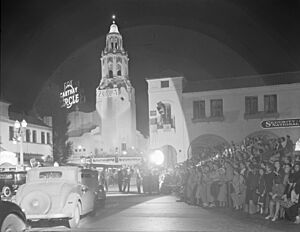Carthay Circle, Los Angeles facts for kids
Quick facts for kids
Carthay Circle
|
|
|---|---|

Carthay Circle neighborhood sign
located on Olympic Boulevard |
|
| Country | |
| State | |
| County | |
| Time zone | Pacific |
| Zip Code |
90048
|
| Area code(s) | 323 |
Carthay Circle is a cool neighborhood in Los Angeles, California. It's part of the Mid-City West area. This neighborhood used to be called Carthay Center. It got its new name from the famous Carthay Circle Theatre.
Contents
Where is Carthay Circle?
Carthay Circle is surrounded by some well-known streets. To the north is Wilshire Boulevard. Olympic Boulevard is to the south. Fairfax Avenue is on the east, and Schumacher Drive is on the west.
You'll find South Carthay just south of Olympic Boulevard. The famous city of Beverly Hills is right next door to the west.
A Look at History
Carthay Circle started as a fancy neighborhood in 1922. It was developed by J. Harvey McCarthy. He created this 136-acre community. Many of the homes here are in the Spanish Revival style.
What's special is that no two homes are exactly alike. This is because every house had to be designed by an architect. Famous designers like Irving Gill and Paul Williams helped create these unique homes.
The overall plan for Carthay Circle was made by architects Aleck Curlett and Claud Beelman. They worked with landscape designers Cook & Hall. One of these designers, Wilbur D. Cook, also planned the nearby city of Beverly Hills.
J. Harvey McCarthy named the streets after important people from the California Gold Rush. He also planned the neighborhood around a shopping center.
Carthay Circle was one of the first planned communities in Los Angeles. It was also the first in the city to have its power lines and pipes underground. The success of Carthay Circle helped the whole Mid-City area grow.
The Famous Carthay Circle Theatre
The most important part of the neighborhood was the Carthay Circle Theatre. It was called the "Showplace of the Golden West." This theater opened on May 18, 1926. It quickly became the main attraction of Carthay Center.
Many famous movies had their premieres here. This includes Disney's Snow White and the Seven Dwarfs. That was Disney's first full-length animated movie! The West Coast premiere of Gone with the Wind also happened here.
The theater was so important that it inspired the community. They decided to change the neighborhood's name from "Carthay Center" to "Carthay Circle." Sadly, the theater was torn down in 1969. An office complex was built in its place.
Today, you can see a large copy of the Carthay Circle Theater. It opened in 2012 at Disney California Adventure Park in Anaheim, California.
Neighborhood Signs and Trees
In November 1983, official neighborhood signs were put up. This happened with help from councilman Zev Yaroslavsky.
On July 11, 1987, the neighborhood had a special ceremony. They celebrated planting 100 new trees. They also put up two big concrete monuments with "Carthay Circle" written on them. These monuments are at McCarthy Vista and Wilshire Boulevard, and at San Vicente Boulevard and Fairfax Avenue.
Parks and Fun Spots
- Carthay Circle Park - This park is located where McCarthy Vista and Crescent Heights Boulevard meet. The City of Los Angeles takes care of it.
Important Landmarks
The Pioneer is a statue by Henry Lion. It was made to be part of a fountain in Carthay Circle Park. The statue is about seven feet tall and weighs 512 pounds. It was put in place on September 25, 1924.
This statue is also known as "Dan the Miner." It went missing in 2009. It was stolen during a time when copper prices were very high. Luckily, the statue was found, fixed, and put back in 2010.
There are also historical markers in the area. These markers were placed by groups like the Native Sons of the Golden West. They honor important figures like Portolá, Juan Bautista de Anza, and Jedediah Strong Smith.
Protecting History
Carthay Circle has a special rule called a Historic Preservation Overlay Zone (HPOZ). This rule helps protect the historic look of the neighborhood. It started on July 24, 1998. The plan to preserve Carthay Circle was officially adopted on December 9, 2010.
The HPOZ helps keep the character of old buildings and sites safe. It also protects the historic streets and how the neighborhood was built.
Images for kids





